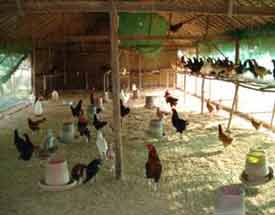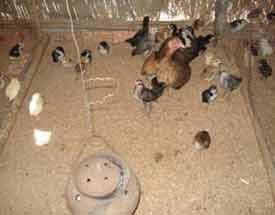Poultry farming
In September 2005 through the OSRO/CMB/401/GER called ‘Emergency Assistance for prevention, diseases investigation, control and surveillance of the Avian Influenza in the Kingdom of Cambodia , FAO and the National Animal Health and Production Investigation Centre (NAPHIC) made a contract for 1 year (September 2005-August 2006) to produce 200 fertile eggs per week for NAPHIC. The bio-security system was established of which hens and cocks are fully confined and not wild birds were allowed to go in the pen. Hens and cocks were not vaccinated against any disease. In early 2006, CelAgrid established several units of small bio-security system to develop alternative technology for the small scale chicken keepers in the rural area to contribute to the control of Avian Influenza and at the same allow farmers to continue benefiting from their chicken production.
Although the FAO/NAPHIC contract finished CelAgrid continues to keep hens and cocks and expand the activities through research supported by MEKARN aiming at producing up to date technologies to fight Avian Influenza. The total number of chickens at present is 251 heads; 30 corks, 110 hens, 16 brooding hens and 95 growing chickens. It is proved that reducing the days of brooding or removing hens immediately after hatching from their chicks, the productivity of hens increase. Chickens are feed with home-made feed using soybean meal, broken rice and rice bran while supplementing water spinach in fresh matter.
Although at present they are under the experiment, muscovy and common ducks are also kept at CelAgrid for eggs and meat.
|

Hens and cocks kept in bio-security system |

Managing hen to improve her productivity |
|